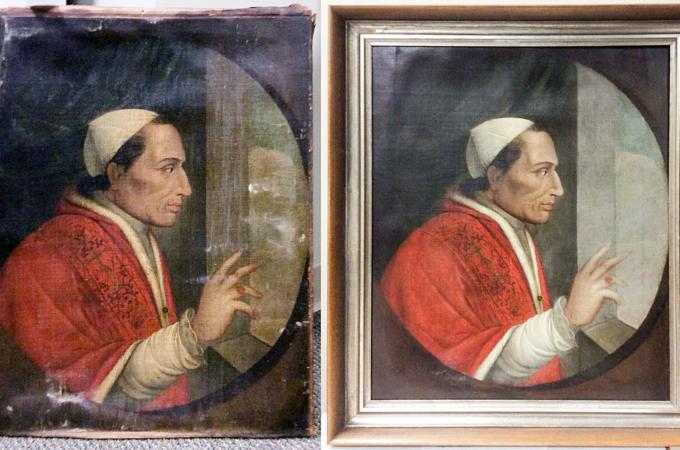Portrait of Pius VII restored
The archive recently restored a painting of Pope Pius VII, who was elected Pope on March 14, 1800, and served until his death on Aug. 20, 1823. While he is best known for guiding the Catholic Church through a tumultuous period in European history, he is also responsible for creating the Diocese of Boston in 1808. This oil-on-canvas piece was created shortly afterward, dating to the 1810s.
Pius VII was born Barnaba Chiaramonti, in Cesena, Italy, on Aug. 14, 1742. He was a distant relative of Pope Pius VI, on his mother's side of the family, and she herself entered the convent of the Carmelites after being widowed in 1750. He entered the Benedictines in 1756, at the age of 14, taking the name of Gregorio and pronouncing his vows two years later. It is noted that when he finished his studies, he was left with a strong desire to spiritualize the Church and move it away from worldly interests.
After completing his formal education, Pius VII taught at the Abbey of St. John in Parma, from 1766 to 1775, and then St. Anselm's, in Rome, until 1781. In 1783, he was appointed Bishop of Tivoli, and two years later Bishop of Imola, being elevated to cardinal simultaneously. Following the death of Pius VI, he travelled to Rome and took part in the papal conclave which lasted from Dec. 8, 1799, to March 14, 1800, and saw him selected as the new pope. He returned to Rome to assume this new role on July 3 of that year.
While fulfilling his previous assignments, Pius VII was constantly confronted with the political instability of the states surrounding him, and this trend would continue as his elevation to pope coincided with the rise of Napoleon in France. Out of this came the Concordat of 1801, which was produced following lengthy negotiations, and regulated relations between the Church and the state in France.
Amid some objections, Pius VII also attended Napoleon's consecration as emperor on Dec. 2, 1804, approving several exceptions to the ceremony -- such as permitting Napoleon to crown himself. Despite this gesture, tensions remained between the Holy Father and the Emperor, and only grew worse as Napoleon crowned himself King of Italy in 1805. Always steering towards a neutral course, Pius VII feared the Vatican would soon become a vassal state of France.
Further events led to Pius VII's capture by French forces on July 10, 1809, at which time he was deported to Savona, Italy, and held captive. Three years later, he was moved to Fontainebleau, outside of Paris, where Napoleon hoped to convince him to acquiesce to his demands. This meeting produced the Concordat of Fontainebleau, which Pius VII later rescinded. Napoleon's failed military campaign in Russia, and subsequent military reversals, resulted in Pius VII being released, and he finally returned to Rome on May 24, 1814.
It is widely acknowledged that Pius VII saw the Church through one of the most tumultuous times in European history. His was a constant struggle of trying to keep the Church's values intact amidst a rapidly changing world, while at the same time trying to placate belligerent parties. He is often admired for his ability to make major decisions at critical moments, keeping the Church on course for political neutrality.
The painting was restored by John Arapoff of J. Arapoff Images. A second generation artist, his father was an accomplished painter who, following his conversion to Catholicism, focused on painting and restoring religious icons. An artist himself, John also appraises and professionally restores paintings and frames. He has previously done work for the Archdiocese of Boston and St. John's Seminary, among others, and stated that he is thrilled to have the opportunity to work for the Catholic Church.



















